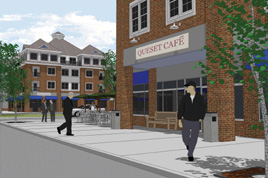Specialty
Air Quality
SECTOR
Commercial
TYPE
Environmental Study
CLIENTELE
Private Sector
TIMESPAN
2009LOCATION
Easton, MA
Project Number:
3105Queset Commons
SERVICE:
Greenhouse Gas Analysis for Mixed-Use Development
DESCRIPTION:
Tech Environmental was retained by D&B King Builders, Inc. to conduct mesoscale and greenhouse gas (GHG) emissions analyses for the proposed Queset Commons 40R mixed-use development to be located in Easton, Massachusetts. This analysis was included in a Draft Environmental Impact Report (DEIR). The full build-out of the development was to consist of nine buildings total: two 4-story condominium buildings, two mixed-use residential and retail/commercial buildings, a conference center, a food market, two office buildings, and a wastewater treatment plant building.
Tech calculated mesoscale emissions of volatile organic compounds (VOC) and oxides of nitrogen (NOx) were for four scenarios: 2008 Existing, 2013 No-Build, 2013 Build, and 2013 Build with Mitigation. This analysis used the US Environmental Protection Agency (EPA) MOBILE6.2 Mobile Source Emission Factor Model. For the 2013 Build with Mitigation scenario, Tech included a comprehensive list of Transportation Demand Management (TDM) strategies and roadway/traffic signal improvements to mitigate the Project's potential air quality impacts including emissions of the greenhouse gas carbon dioxide (CO2). These measures will improve traffic operations, reduce Project generated vehicle trips, and are estimated to reduce Project-related motor vehicle NOx, VOC and CO2 emissions by 2%.
Tech also performed a GHG emissions analysis for the proposed Project using the Tech Environmental Energy Model. CO2 emissions were quantified for: (1) the base case corresponding to the 7th Edition of the Massachusetts Building Code, (2) the Preferred Alternative, which includes the proposed energy saving design features, and (3) an Additional Mitigation Alternative, which includes additional energy savings elements and Transportation Demand Management (TDM) measures. For the proposed final design, this analysis included mitigation measures that reduce the Project's direct and indirect stationary source energy-related emissions of CO2 by approximately 18% and 22%, respectively.
Overall, mitigation measures in the Additional Mitigation Alternative are expected to reduce the Project's total CO2 emissions by approximately 11% compared to the base case.

